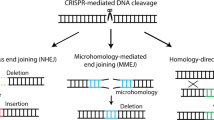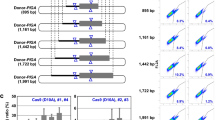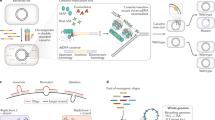Abstract
Chimeric RNA/DNA oligonucleotides have been used successfully to correct point and frameshift mutations in cells as well as in animal and plant models. This approach is one of several nucleic acid repair technologies that will help elucidate the function of newly discovered genes. Understanding the mechanisms by which these different technologies direct gene alteration is essential for progress in their application to functional genomics.
This is a preview of subscription content, access via your institution
Access options
Subscribe to this journal
Receive 12 print issues and online access
$209.00 per year
only $17.42 per issue
Buy this article
- Purchase on Springer Link
- Instant access to full article PDF
Prices may be subject to local taxes which are calculated during checkout

© Bob Crimi

© Bob Crimi


Similar content being viewed by others
References
Cech, T.R. Ribozymes and their medical implications. J.A.M.A. 260, 3030–3034 (1988).
Rossi, J.J. Ribozymes. Curr. Opin. Biotechnol. 3, 3–7 (1992).
Yu, M., Poeschla, E. & Wong-Staal, F. Progress towards gene therapy for HIV infection. Gene Ther. 1, 13–26 (1994).
Phylactou, L.A., Darrah, C. & Wood, M.J.A. Ribozyme-mediated trans-splicing of a trinucleotide repeat. Nat. Genet. 18, 378–381 (1998).
Lan, N. et al. Ribozyme-mediated repair of sickle β-globin mRNAs in erythrocyte precursors. Science 280, 1593–1596 (1998).
Long, M.B. & Sullenger, B.A. Evaluating group I intron catalytic efficiency in mammalian cells. Mol. Cell. Biol. 19, 6479–6487 (1999).
Zarrinkar, P.P. & Sullenger, B.A. Optimizing the substrate specificty of a group I intron ribozyme. Biochemistry in press (2001).
Sierakowska, H., Sambade, M.J., Agrawal, S. & Kole, R. Repair of Thalassemic human β-globin mRNA in mammalian cells by antisense oligonucleotides. Proc. Natl. Acad. Sci. USA 93, 12840–12844 (1996).
Sierakowska, H., Gorman, L., Kang, S.H. & Kole, R. Antisense oligonucleotides and RNAs as modulators of pre-mRNA splicing. Methods Enzymol. 313, 506–521 (2000).
Wilton, S.D. et al. Specific removal of the nonsense mutation from the mdx dystrophin mRNA using antisense oligonucleotides. Neuromuscul. Disord. 9, 330–338 (1999).
Guo, H. et al. Group II introns designed to insert into therapeutically relevant DNA target sites in human cells. Science 289, 452–457 (2000).
Chan, P.P. et al. Targeted correction of an episomal gene in mammalian cells by short DNA fragment tethered to a triplex-forming oligonucleotide. J. Biol. Chem. 274, 11541–11548 (1999).
Culver, K.W. et al. Correction of chromosomal point mutations in human cells with bifunctional oligonucleotides. Nat. Biotechnol. 10, 989–993 (1999).
Parekh, H. et al. The DNA strand of chimeric RNA/DNA oligonucleotides can direct gene repair/conversion activity in mammalian and plant cell-free extracts. Nucleic Acids Res. 28, 4332–4339 (2000).
Santoro, S.W. & Joyce, G.F. Mechanism and utility of an RNA-cleaving DNA enzyme. Biochemistry 38, 13330–13342 (1998).
Burgin, A.B., Parodos, K., Lane, D.J. & Pace, N.R. The excision of intervening sequences from Salmonella 23S ribosomal RNA. Cell 60, 405–414 (1990).
Jaeger, L., Wright, M.C. & Joyce, G.F. A complex ligase ribozyme evolved in vitro from a group I ribozyme domain. Proc. Natl. Acad. Sci. USA 96, 14712–14717 (1999).
Kmiec, E.B. Targeted gene repair. Gene Ther. 6, 1–3 (1999).
Gamper, H.B. et al. A plausible mechanism for gene correction by chimeric oligonucleotides. Biochemistry 39, 5808–5816 (2000).
Cole-Strauss et al. Targeted gene repair directed by chimeric RNA/DNA oligonucleotide in mammalian cell-free extract. Nucleic Acids Res. 27, 1323–1330 (1999).
Rice, M.C., May, G.D., Kipp, P.B., Parekh, H. & Kmiec, E.B. Genetic repair of mutations in plant cell-free extracts directed by specific chimeric oligonucleotides. Plant Physiol. 123, 1–11 (2000).
Yoon, K., Cole-Strauss, A. & Kmiec, E.B. Targeted gene correction of episomal DNA in mammalian cells mediated by a chimeric RNA/DNA oligonucleotide. Proc. Natl. Acad. Sci. USA 93, 2071–2076 (1996).
Cole-Strauss, A. et al. Correction of the mutation responsible for sickle cell anemia by an RNA-DNA oligonucleotide. Science 273, 1386–1389 (1996).
Kren, B.T., Cole–Strauss, A., Kmiec, E.B. & Steer, C.J. Targeted nucleotide exchange in the alkaline phosphatase gene of HuH-7 cells mediated by a chimeric oligonucleotide. Hepatology 25, 1462–1468 (1997).
Kren, B.T., Bandyopadhyay, P. & Steer, C.J. In-vivo site-directed mutagenesis of the factor IX gene by chimeric RNA/DNA oligonucleotides. Nat. Med. 4, 285–290 (1998).
Alexeev, V. & Yoon, K. Stable and inheritable changes in genotype and phenotype of albino melanocytes induced by an RNA–DNA oligonucleotide. Nat. Biotechnol. 16, 1343–1346 (1998).
Lai, L.W., O'Connor, H.M. & Lien, Y.H. In Conference Proceedings, 1st Annual Meeting of the American Society of Gene Therapy May 21–31, 1998. (American Society of Gene Therapy, Seattle, WA; 1998).
Lai, L.-W., Chau, B. & Lien, Y.-H.H. In vivo gene targeting in carbonic anhydrase II deficient mice by chimeric RNA/DNA oligonucleotides. In Conference Proceedings, 2nd Annual Meeting of the American Society of Gene Therapy. May 21–31, 1998. (American Society of Gene Therapy, Seattle, WA; 1999).
Kren, B.T. et al. Correction of the UDP–glucuronosyltransferase gene defect in the Gunn rat model of Criglar-Najjar syndrome type I with a chimeric oligonucleotide. Proc. Natl. Acad. Sci. USA 96, 10349–10354 (1999).
Alexeev, V., Igoucheva, O., Domashenko, A., Cotsavelis, G. & Yoon, K. Localized in vivo genotypic and phenotypic correction of the albino mutation in skin by RNA/DNA oligonucleotide. Nat. Biotechnol. 18, 43–50 (2000).
Rando, T.A., Disatnik, M.H. & Zhou, L.Z. Rescue of dystrophin expression in mdx mouse muscle by RNA/DNA oligonucleotides. Proc. Natl. Acad. Sci. USA 10, 5363–5368 (2000).
Bartlett, R.J. et al. In vivo targeted repair of a point mutation in the canine dystrophin gene by a chimeric RNA/DNA oligonucleotide. Nat. Biotechnol. 18, 615–622 (2000).
Hohn, B. & Puchta, H. Gene therapy in plants. Proc. Natl. Acad. Sci. USA 96, 8321–8323 (1999).
Beetham, P.R., Kipp, P.B., Sawyky, X.L., Antzen, C. & May, G.D. A tool for functional plant genomics: chimeric RNA/DNA oligonucleotides cause in vivo gene-specific mutations. Proc. Natl. Acad. Sci. USA 15, 8774–8778 (1999).
Zhou, T. et al. Targeted manipulation of maize genes in vivo using chimeric RNA/DNA oligonucleotides. Proc. Natl. Acad. Sci. USA. 96, 8768–8773 (1999).
Zhou, T. et al. Engineering herbicide-resistant maize using chimeric RNA/DNA oligonucleotides. Nat. Biotechnol. 18, 555–558 (2000).
Parekh-Olmedo, H., Czymmek, K. & Kmiec, E.B. Targeted gene repair in mammalian cells using chimeric RNA/DNA oligonucleotides and modified single-stranded vectors. Science, in press (2001).
Smulevitch, S.V., Simmons, C.G., Norton, J.C., Wise, T.W. & Corey, D.R. Enhancement of strand invasion by oligonucleotides through manipulation of backbone charge. Nat. Biotechnol. 14, 1700–1704 (1996).
Ghoumari, A.M. et al. Gene transfer in hepatocarcinoma cell lines: in vitro optimization of a virus-free system. Gene Ther. 3, 483–490 (1996).
Lee, R.J. & Huang, L. Folate-targeted, anionic liposome-entrapped polylysine-condensed DNA for tumor cell-specific gene transfer. J. Biol. Chem. 271, 8481–8487 (1996).
Remy, J.S., Kichler, A., Mordvinov, V., Schuber, F. & Behr, P.-P. Targeted gene transfer into hepatoma cells with lipopolyamine-condensed DNA particles presenting galactose ligands: a stage toward artificial viruses. Proc. Natl. Acad. Sci. USA 92, 1744–1748 (1995).
Lappalainen, K., Jââskelâinen, I., Syrjânen, K., Urttl, A. & Syrjânen, S. Comparison of cell proliferation and toxicity assays using two cationic liposomes. Pharm. Res. 11, 1127–1131 (1994).
Litzinger, D.C., Huang, L. Phosphatidylethanolamine liposomes: drug delivery, gene transfer and immunodiagnostic applications. Biochim. Biophys. Acta. 1113, 201–227 (1992).
Bandyopadhyay, P., Kren, B.T., Ma, X. & Steer, C.J. Enhanced gene transfer into HuH–7 cells and primary rat hepatocytes using targeted liposomes and polyethylenimine. Biotechniques 25, 282–292 (1998).
Klein, C. & Raab-Traub, N. Human neonatal lymphocytes immortalized after microinjection of Epstein–Barr virus DNA. J. Virol. 61, 1552–1558 (1987).
Davis, B.R. et al. Glass needle-mediated microinjection of macromolecules and transgenes into primary human blood stem/progenitor cells. Gene Ther. 95, 437–444 (2000).
Griffin, B.A., Adams, S.R. & Tsien, R.Y. Specific covalent labeling of recombinant protein molecules inside live cells. Science 281, 269–272 (1998).
Murray, A.W. & Szostak, J.W. Pedigree analysis of plasmid segregation in yeast. Cell 34, 961–970 (1983).
Acknowledgements
We thank our many colleagues for providing us with information regarding their work, and we apologize for any omissions due to space limitations. This work was supported in part by grants from the National Institutes of Health. Special thanks go to Eric M. Roberts for his outstanding graphic and technical skills during manuscript preparation.
Author information
Authors and Affiliations
Corresponding author
Supplementary information
Rights and permissions
About this article
Cite this article
Rice, M., Czymmek, K. & Kmiec, E. The potential of nucleic acid repair in functional genomics. Nat Biotechnol 19, 321–326 (2001). https://doi.org/10.1038/86701
Received:
Accepted:
Issue Date:
DOI: https://doi.org/10.1038/86701
This article is cited by
-
Oligonucleotide-directed gene repair in wheat using a transient plasmid gene repair assay system
Plant Cell Reports (2006)
-
Mammalian cell–based optimization of the biarsenical-binding tetracysteine motif for improved fluorescence and affinity
Nature Biotechnology (2005)
-
Finding needles in haystacks
Nature Biotechnology (2004)
-
A framework for designing transgenic crops—science, safety and citizen's concerns
Nature Biotechnology (2003)
-
Glass needle-mediated microinjection of macromolecules and transgenes into primary human mesenchymal stem cells
Journal of Biomedical Science (2003)



